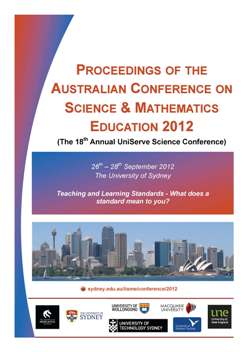Using threshold concepts to design a first year biology curriculum
Abstract
We used a matrix of threshold concepts, which incorporates a network of discipline ideas/processes (Ross et al. 2010) and encapsulates our conceptual understanding of biology, as a useful construct for integrating ‘ways of thinking and practicing as a biologist’ into curriculum design and delivery (Taylor, 2006, 2008). Our new laboratory program for first year biology students focuses more explicitly on key abstract threshold concepts such as hypothesis testing, and scale, using challenging hands-on investigations and increased levels of student independence. We also integrated into the course, a broad range of activities which address key problems in understanding and help students to monitor their progress (Lawson, 2000; Oh, 2010; Pederson, 2011). We used our extensive surveys of students’ understanding of concepts such as hypothesis testing, to create a diagnostic survey instrument (Taylor et al 2012, Zimbardi et al 2012), which could be used to track student progress. Similarly our data on student writing of hypotheses and testing protocols (Taylor and Meyer 2010), which showed a huge variation in understanding of the how and what of testing, led us to design a series of experimental design and interpretive writing activities which allowed students to develop and practice their understanding of the concept. REFERENCES Kim, H. J., & Pedersen, S. (2011) Advancing young adolescents’ hypothesis-development performance in a computer-supported and problem-based learning environment, Computers & Education, doi: 10.1016/j.compedu.2011.03.014 Lawson, A. E. (2003). The nature and development of hypothetico-predictive argumentation, with implications for science teaching. International Journal of Science Education, 25(11), 1387–1408. Oh, P. S. (2010) How can teachers help students formulate scientific hypotheses? Some strategies found in abductive inquiry activities of earth science. International Journal of Science Education, 32(4), 541-560. Ross, P. M., Taylor, C. E., Hughes, C., Kofod, M., Whitaker, N., & Lutze-Mann, L. (2010). Threshold concepts: Challenging the culture of teaching and learning biology. In J. H. F. Meyer, R. Land & C. Baillie (Eds), Threshold Concepts: from theory to practice. (pp165-178), Rotterdam: Sense Publishers. Taylor, C. E. (2006). Threshold concepts in biology: Do they fit the definition? In J. H. F. Meyer & R. Land (Eds), Overcoming Barriers to Student Understanding: Threshold Concepts and Troublesome Knowledge, (pp87-99), London: Routledge. Taylor, C. E. (2008). Threshold concepts, troublesome knowledge and ways of thinking and practising. In R. Land, J. H. F. Meyer, & J. Smith (Eds) Threshold Concepts within the Disciplines, (pp185-197), Rotterdam: Sense Publishers. Taylor, C. E. and Meyer, J. H. F. (2010). The testable hypothesis as a threshold concept for biology students. In J. H. F. Meyer, R. Land & C. Baillie (Eds), Threshold Concepts: from theory to practice, (pp179-192), Rotterdam: Sense Publishers. Zimbardi, K., Meyer, J. H. F., Chunduri, P., Taylor, C. E., Ross, P. M., Tzioumis, V., & Lluka, L. J. (2012). Student understanding of the critical features of a hypothesis: variation across epistemic and heuristic dimensions. In Threshold Concepts: from personal practice to communities of practice. Proceedings of the 4th Biennial Threshold Concepts Conference, NAIRTL, Dublin, Ireland.Downloads
Published
2012-08-29
Issue
Section
Abstracts
